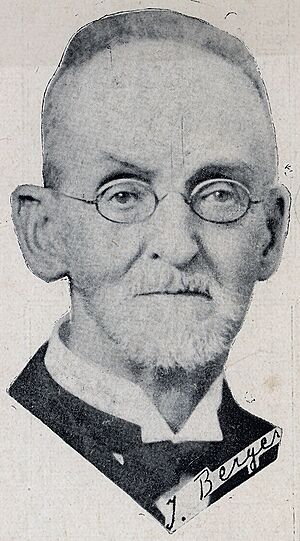Johann Berger facts for kids
Johann Nepomuk Berger was born on April 11, 1845, in Graz, Austria. He passed away on October 17, 1933. Berger was a very important Austrian chess master. He was also a chess expert, a composer of chess puzzles, an author, and an editor.
Contents
Berger's Chess Journey
Johann Berger started his chess career with great success. In September 1870, he won the very first chess tournament ever held in the Austro-Hungarian Empire. This big win happened in his hometown of Graz.
Early Matches and Tournaments
Berger played many matches against other strong players. In 1875, he won a match against Alexander Wittek in Graz. He also had a close match with Paul Lipke in 1896, which ended in a tie.
He took part in many important chess tournaments across Europe. These included events in Berlin, Nuremberg, Hamburg, and Frankfurt. He often placed well, showing his skill against top players of his time.
Later Tournament Play
Berger continued to compete in major tournaments into the early 1900s. He played in events like Cologne 1898, Munich 1900, and Vienna 1907. These tournaments featured some of the world's best chess players.
A Pioneer in Correspondence Chess
Berger was the first Austrian player to win a major international correspondence chess tournament. This means he played chess games by sending moves through mail. He won the Monde Illustré tournament, which lasted from 1889 to 1892. His record was amazing: 45 wins, no losses, and only three draws!
Contributions to Chess Knowledge
Johann Berger was not just a player; he also helped chess grow through his writings and studies.
Chess Author and Editor
He was the editor of a well-known chess magazine called Deutsche Schachzeitung. Berger also wrote several important books about chess. These included:
- Das Schachproblem und dessen Kunstgerechte Darstellung (1884)
- Theorie und Praxis der Endspiele (1890)
- Problemen, Studien und Partien (1914)
Endgame Studies Expert
Berger was especially famous for creating endgame studies. These are like puzzles where you have to find the best moves to win or draw in the final part of a chess game. He published over 100 such studies. Many of his studies helped improve the way people understood chess endgames.
His most famous book, Theorie und Praxis der Endspiele (which means Theory and Practice of the Endgame), was first published in 1891. It was updated in 1922 and again in 1933. This book was the first modern and complete guide to practical endgames. For many decades, it was the main book chess players used to learn about endgames.
The Sonneborn–Berger System
Berger also discussed a special way to break ties in chess tournaments. This system is now called the Sonneborn–Berger system. It's used to decide who wins when players have the same score. Even though he talked about it, he didn't actually invent the system himself.


